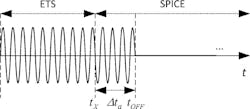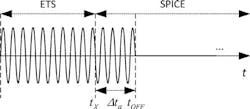Time-Slot Division Strategy Enables Efficient Simulation
This file type includes high resolution graphics and schematics when applicable.
Modern communications signal streams pass through digitally assisted RF nodes, which rely on advanced digital signal processing. This heterogeneous system becomes difficult and computationally expensive to simulate during pulse-width-modulated on and off states. The issue is that the energy stored in RF components, like resonators, needs classical time-step integration methods for simulation. To increase time efficiency for such simulations, David Ferreira, Jorge F. Oliveira, and Jose C. Pedro have developed an automatic time-slot division technique at the University of Coimbra in Portugal.
Their time-slot division strategy automatically switches between envelope-following techniques and time-step integration, depending upon factors involving the signal stimulus. The simulation process is then broken down into regions where either envelope or SPICE-like techniques would be more computationally viable. Simulations are run using a self-oscillating RF power amplifier and an on-off amplitude-shift-keying wireless transmitter (see figure).
A comparison of the new method, SPICE-like engines, and multiple-rate time-step integration techniques was performed. The new method showed notable increases in computational speed compared to the other methods with significant increases over SPICE approaches (greater than 2X). According to the researchers, greater time efficiency is possible with circuits that have a larger discrepancy between the carrier period and the on-state duration when compared to simulated circuits. See “Compact High-Power SPST and SP4T RF MEMS Metal-Contact Switches,” IEEE Transactions on Microwave Theory and Techniques, Jan. 2014, p. 18.
This file type includes high resolution graphics and schematics when applicable.
About the Author
Jean-Jacques DeLisle
Jean-Jacques graduated from the Rochester Institute of Technology, where he completed his Master of Science in Electrical Engineering. In his studies, Jean-Jacques focused on Control Systems Design, Mixed-Signal IC Design, and RF Design. His research focus was in smart-sensor platform design for RF connector applications for the telecommunications industry. During his research, Jean-Jacques developed a passion for the field of RF/microwaves and expanded his knowledge by doing R&D for the telecommunications industry.


